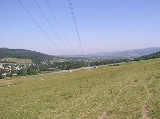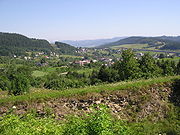
Jablunkov Pass
Encyclopedia

Mountain pass
A mountain pass is a route through a mountain range or over a ridge. If following the lowest possible route, a pass is locally the highest point on that route...
in the Beskids
Beskids
The Beskids , ) is a traditional name for a series of Eastern European mountain ranges.- Definition :The Beskids are approximately 600 km in length and 50–70 km in width...
, located in the elevation of 553 m above sea level, in the Czech Republic
Czech Republic
The Czech Republic is a landlocked country in Central Europe. The country is bordered by Poland to the northeast, Slovakia to the east, Austria to the south, and Germany to the west and northwest....
, near the border with Poland
Poland
Poland , officially the Republic of Poland , is a country in Central Europe bordered by Germany to the west; the Czech Republic and Slovakia to the south; Ukraine, Belarus and Lithuania to the east; and the Baltic Sea and Kaliningrad Oblast, a Russian exclave, to the north...
and Slovakia
Slovakia
The Slovak Republic is a landlocked state in Central Europe. It has a population of over five million and an area of about . Slovakia is bordered by the Czech Republic and Austria to the west, Poland to the north, Ukraine to the east and Hungary to the south...
.
It separates the Moravian-Silesian Beskids
Moravian-Silesian Beskids
The Moravian-Silesian Beskids is a mountain range in the Czech Republic with a small part reaching to Slovakia. It lies on the historical division between Moravia and Silesia, hence the name...
and the Silesian Beskids
Silesian Beskids
Silesian Beskids is one of the Beskids mountain ranges in Outer Western Carpathians in southern Silesian Voivodeship, Poland and the eastern Moravian-Silesian Region, Czech Republic.Most of the range lies in Poland...
mountain ranges. It is one of the most important transport routes in the Western Carpathians
Western Carpathians
The Western Carpathians are a mountain range and geomorphological province that forms the western part of the Carpathian Mountains.The mountain belt stretches from the Low Beskids range of the Eastern Carpathians along the border of Poland with Slovakia toward the Moravian region of the Czech...
. Road
European route E75
European route E 75 is part of the International E-road network, which is a series of main roads in Europe.The E 75 starts from Vardø, Norway in the Barents Sea and runs south through Finland, Poland, Czech Republic, Slovakia, Hungary, Serbia and Republic of Macedonia to Sitia, Greece on...
from Žilina
Žilina
Žilina is a city in north-western Slovakia, around from the capital Bratislava, close to both the Czech and Polish borders. It is the fourth largest city of Slovakia with a population of approximately 85,000, an important industrial center, the largest city on the Váh river, and the seat of a...
to Těšín
Ceský Tešín
Český Těšín is a town in the Karviná District, Moravian-Silesian Region of the Czech Republic. The town is commonly known in the region as just Těšín . It lies on the west bank of the Olza River, in the heart of the historical region of Cieszyn Silesia...
runs here. Košice-Bohumín railway line
Košice-Bohumín Railway
The Košice–Bohumín Railway can refer to:*originally: A private railway company established in 1869 in Austria-Hungary. In 1924 the company was nationalised and put under the Czechoslovak State Railways....
also runs here. It was an important route from the Middle Ages
Middle Ages
The Middle Ages is a periodization of European history from the 5th century to the 15th century. The Middle Ages follows the fall of the Western Roman Empire in 476 and precedes the Early Modern Era. It is the middle period of a three-period division of Western history: Classic, Medieval and Modern...
, connecting Upper Hungary
Upper Hungary
Upper Hungary is the usual English translation for the area that was historically the northern part of the Kingdom of Hungary, now mostly present-day Slovakia...
with Silesia
Silesia
Silesia is a historical region of Central Europe located mostly in Poland, with smaller parts also in the Czech Republic, and Germany.Silesia is rich in mineral and natural resources, and includes several important industrial areas. Silesia's largest city and historical capital is Wrocław...
, more precisely Cieszyn Silesia
Cieszyn Silesia
Cieszyn Silesia or Těšín Silesia or Teschen Silesia is a historical region in south-eastern Silesia, centered around the towns of Cieszyn and Český Těšín and bisected by the Olza River. Since 1920 it has been divided between Poland and Czechoslovakia, and later the Czech Republic...
.
Archaeological researches suggest it was an important route long before the Middle Ages. Travelling caravans were frequently attacked by bandits, so some fortifications were built in the place of today's Mosty u Jablunkova
Mosty u Jablunkova
is a village in the Moravian-Silesian Region of the Czech Republic, located in the Jablunkov Pass. It has 3,997 inhabitants, 18.3% of the population are the Poles. 83.9% of the population are religious, of whom 93.8% are Catholic...
. Archaeologists presume they were built in the 13th century. Importance of this trade route grew over time and in 1529 in the fear of Turkish
Ottoman Empire
The Ottoman EmpireIt was usually referred to as the "Ottoman Empire", the "Turkish Empire", the "Ottoman Caliphate" or more commonly "Turkey" by its contemporaries...
attack, new fortifications (pl: szańce, cs: šance) were built. It played an important role during the Thirty Years' War
Thirty Years' War
The Thirty Years' War was fought primarily in what is now Germany, and at various points involved most countries in Europe. It was one of the most destructive conflicts in European history....
. After war it was renovated and new larger one were built nearby by Elżbieta Lukrecja, Duchess of Cieszyn
Duchy of Cieszyn
The Duchy of Cieszyn or Duchy of Teschen or Duchy of Těšín was an autonomous Silesian duchy centered on Teschen in Upper Silesia. After the feudal division of Poland it was split off in 1281 and ruled by Silesian dukes from the Piast dynasty since 1290...
. It eventually became a station with permanent garrison. Fortifications were last time renovated in 1808. It dilapidated from that time and locals picked up its parts as a construction material. Remains of this fortifications are today a popular tourist spot.
In October 1938 the whole Zaolzie
Zaolzie
Zaolzie is the Polish name for an area now in the Czech Republic which was disputed between interwar Poland and Czechoslovakia. The name means "lands beyond the Olza River"; it is also called Śląsk zaolziański, meaning "trans-Olza Silesia". Equivalent terms in other languages include Zaolší in...
area including this mountain pass was captured by Poland. On the night of August 25/26, 1939 Jabłonków Incident
Jabłonków Incident
Jabłonków Incident refers to the events of the night of August 25/26, 1939, along the Polish - Slovak border. On that night, a group of German Military Intelligence armed agents attacked a rail station in Mosty. The main purpose of the attack was to capture the Jablunkov Pass, with its strategic...
occurred here, when a group of armed German
Nazi Germany
Nazi Germany , also known as the Third Reich , but officially called German Reich from 1933 to 1943 and Greater German Reich from 26 June 1943 onward, is the name commonly used to refer to the state of Germany from 1933 to 1945, when it was a totalitarian dictatorship ruled by...
Abwehr
Abwehr
The Abwehr was a German military intelligence organisation from 1921 to 1944. The term Abwehr was used as a concession to Allied demands that Germany's post-World War I intelligence activities be for "defensive" purposes only...
agents of the Brandenburg Regiment
Brandenburgers
The Brandenburgers were members of the Brandenburg German Special Forces unit during World War II.Units of Brandenburgers operated in almost all fronts - the invasion of Poland, Denmark and Norway, in the Battle of France, in Operation Barbarossa, in Finland, Greece and the invasion of Crete,...
attacked the rail station in Mosty. The Jabłonków Incident has been named the first commando operation of the Second World War.
The village of Mosty u Jablunkova
Mosty u Jablunkova
is a village in the Moravian-Silesian Region of the Czech Republic, located in the Jablunkov Pass. It has 3,997 inhabitants, 18.3% of the population are the Poles. 83.9% of the population are religious, of whom 93.8% are Catholic...
lies in the pass.

